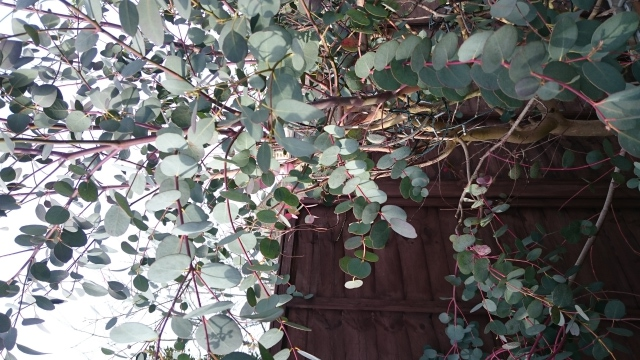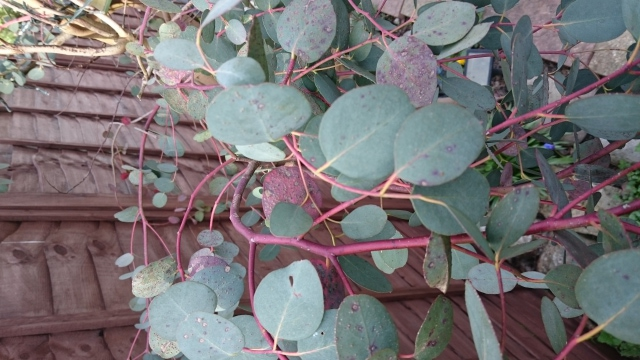Question
 eucalyptus silver doll
eucalyptus silver doll  eucalyptus silver doll
eucalyptus silver doll
I have a Eucalyptus Cinerea Silver dollar tree in my garden in the UK. It is well established and about 2.5m high.
It appears to have raised red spots on many of the leaves. Is this a rust (fungus) infection?
How can this be treated?
AnswerSounds like leaf spot disease.
Leaf spot is a common descriptive term applied to a number of diseases affecting the foliage of ornamentals and shade trees. The majority of the leaf spots are caused by a variety of fungal pathogens but some are caused by bacteria.
The primary symptom of a leaf spot disease is spots on foliage. The spots will vary in size and color depending on the plant affected the specific organism involved, and the stage of development. Spots are most often brownish, but may be tan or black. Concentric rings or a dark margin around the spot may be present. Fungal bodies may appear as black dots in the center of the spots. Over time the spots may combine to enlarge to form blotches. Leaves may yellow and drop prematurely.
The organisms that cause leaf spots survive in fallen infected leaves and twigs. Some may remain in dead twigs on the tree. During wet weather, spores are released which may splashed or be windblown onto newly emerging tender leaves where they germinate in the moisture and infect the leaf. Overhead watering late in the day or during the night, heavy dews and close spacing of plants prolong wetting of the leaf surface and provide more opportunities for fungal or bacterial infections.
Live with the disease. Leaf spots are largely an aesthetic problem as few leaf spots seriously damage the host. Also control is seldom achieved after the infection has started.
Remove infected leaves and dead twigs. Raking up and disposing of infected leaves as they drop and pruning out dead twigs can help control the disease by removing spores that can reinfect the new leaves. This will not cure the problem but it can help minimize infections.
Keep foliage dry. Avoid overhead watering. Use soaker hoses or water early in the day so the foliage can dry before night. Watering can also spread the disease by splashing. Prune plants and space plants to allow for good air circulation that promotes rapid drying of foliage.
Keep plants healthy. Since most plants can tolerate some defoliation, keep them in good health so they can rebound quickly. Avoid over fertilization as it promotes a flush of young leaves that are more susceptible to attack by insects and disease.
In rare cases of severe infection where the size and value of plants make it practical, applications of fungicides may be helpful. Generally fungicidal control is warranted if: 1) repeated defoliations occur in one year or subsequent years, 2) the plant is under stress, 3) the plant is in decline, 4) the plant is a needled evergreen or 5) the disease is black spot of roses. Sprays will not cure the infection but protect leaves from becoming infected. To be effective fungicidal sprays must be begun at bud break before symptoms are noted and be continued at intervals specified by the label (usually 10-14 days) through the period of spring rains. Spraying after infection is present will provide little benefit. Recommendations will vary with the disease and fungicide used. Some recommended fungicides for control of leaf spot diseases are: chlorothalonil (Daconil 2787 or Bravo), fixed coppers, mancozeb, maneb and zineb. Check with your local garden type store for these products and follow the instructions on the product. IF used now they will not control the spots on the leaves but if used in the spring they prevent leaf spots from forming.
In leaf spots I would not worry about them. Next year depending on the weather conditions you will more than likely not see any problem. Leaf spots will not seriously harm the tree.







